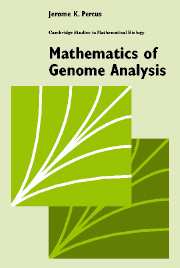4 - Sequence Comparison
Published online by Cambridge University Press: 04 December 2009
Summary
Having examined aspects of the general structure of the language of DNA, we continue to home in on the words, phrases, etc., of the language. A word of course is a subsequence that recurs in the same or another organism, either exactly, or distorted, or in synonym form; a phrase consists of key words together perhaps with filler. We will save for Section 4.3 the question of how potential words or phrases are located in the first place in our new more general context, and concentrate now on the degree of confidence with which we can assert that these objects have indeed been found. It must be emphasized that we are only attending to linear ordering, the primary structure of the molecule, so that proteins, for example, correspond simply to coding linear subsequences; the fashion in which the distinctive three-dimensional structure arises, clearly crucial for proteins and hardly irrelevant for DNA, is not being addressed.
Basic Matching
The prototypical situation to be analyzed is this: Two linear chains of length l (nucleotides, amino acids, …,), when aligned, are found to have a common (contiguous) subsequence of r units. What is the probability that this was a random event and not an indicator of a functional or an evolutionary relationship between the chains? At the most primitive level of resolution, random means independent selection of the units at the overall frequencies, pα for the αth type of unit, α = 1, …, n(n = 4, 20, …).
- Type
- Chapter
- Information
- Mathematics of Genome Analysis , pp. 81 - 117Publisher: Cambridge University PressPrint publication year: 2001



